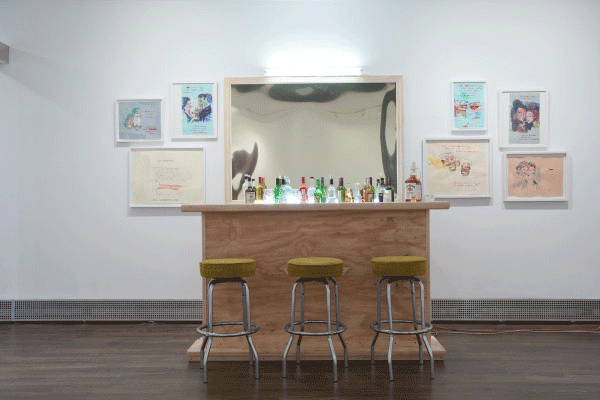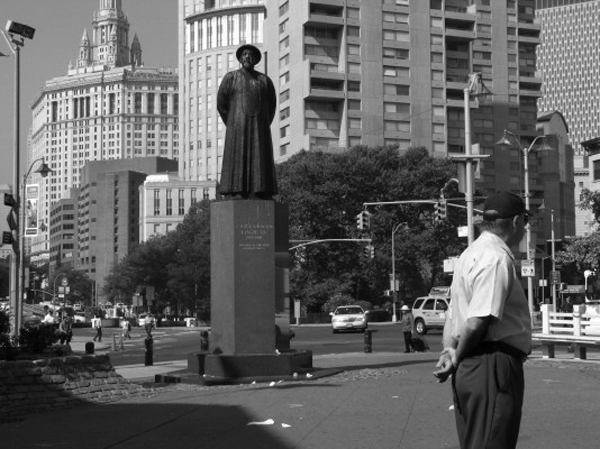-
Other Halves, Lived: Lush Life on the Lower East Side
by Daniel Pearce July 29, 2010

If the 1890 publication of Jacob Riis’s How the Other Half Lives offered an immersive vision of a destitute Lower East Side, it also presumed a remoteness for its readership proportional to the brutality of Riis’s imagery. The iconic shots of sweatshops, forbidding alleyways, overcrowded tenement bedrooms, and scores of children pretending to sleep in public, little heaps of contrived exhaustion—they have lost their ability to horrify in any novel way. The images did, of course, horrify in a completely novel way upon their first publication; the very title of Riis’s book announces the estrangement of his audience from his subjects, from “those who were underneath,” as he describes them.
The moral universe of How the Other Half Lives is born out of such binary oppositions, with one financially secure—and, incidentally, photo-appreciating—half of the population rendering the other “Other.” By framing poverty and privilege in terms of bastardized codependency, with the “underneath” already implying the oblivious “above,” Riis’s book outlines not only the specific circumstances of Lower East Side destitution, but also the mutual inaccessibility of the two halves to one another. As Martha Rosler writes,
In contrast to the pure sensationalism of much of the journalistic attention to working-class, immigrant and slum life, the meliorism of Riis … argued for the rectification of wrongs … [and] the assumption that [those wrongs] were tolerated rather than bred marks a basic fallacy of social work.… Charity is an argument for the preservation of wealth and reformist documentary represented an argument within a class about the need to give a little in order to mollify the classes below… (Second emphasis mine)
The sense of desperation that appeared in How the Other Half Lives continues to underpin contemporary photographs of systemic suffering: It is a kind of mannered striving to make unimaginable situations vivid for viewers whose disapproval, it is dearly wished, carries enough currency to bring necessary aid. At its most optimistic, Riis’s book hopes that merely by introducing the impoverished to the privileged, some attenuation of suffering that might be had.

Revisiting this same terrain today, one can see that the Lower East Side is now “whole.” Or rather, it has been settled by the twentieth-century equivalents of Riis’s two halves, becoming a staging area for them to largely ignore each other. The “half,” however, is not really the relevant unit for approaching the demographic splits among those who currently call the neighborhood home. Now it’s much more complicated. Richard Price’s novel Lush Life, set in the post-9/11 Lower East Side, accurately charts the variegated landscape of identities: There are the Orthodoxim, the old-guard Irish families, the “pioneers” (Price’s term for the artists who arrived “early,” making the neighborhood eligible for white people more generally), the ensuing “La Bohèmers” (alternately known as “Young, White, and Gifted”), the predominantly black and Hispanic residents of the Lemlich Houses (a fictional housing projects based on the Alfred E. Smith Houses), a diverse Chinese population, and a smattering of Israeli and Yemeni immigrants, all of them navigating the same begrudgingly shared territory.
In the late 19th century, Riis’s subjects had no means of visually capturing their own condition, placing it on display, and demanding a response; now, in this same area, each of these tasks can be accomplished internally—the area is now flush with galleries, most of which arrived on the heels of the art-making “pioneers”—and that is exactly what a current group exhibition sets out to do. Inspired by Price’s novel, Lush Life is an incredibly ambitious show, with its participating galleries falling into the novel’s geographic constellation of activity.
Price’s panorama revolves around the mugging and accidental murder of Ike Marcus, a “Young, White, and Gifted” bartender who had just begun working at Café Berkmann (based on Schiller’s) at the time of his death. Owing a debt to Jens Hoffmann’s work at the Wattis Institute, curators Omar Lopez-Chahoud and Franklin Evans attempt something functionally similar to Price’s novel, by offering, in the words of the press release, “a potent vehicle for the consideration of community as voices compete for, ignore, and occasionally share the same physical and conceptual space.” Lopez-Chahoud and Evans have installed shows in nine galleries, each representing “the idea of one of the nine chapters in the book.”
Using a novel as a way of organizing artwork activates two curatorial impulses, both of which undergird much of the work on view here. The first is to focus on atmosphere, to address the novel’s setting and thematic index without offering any chunky narrative bits; conversely, there is an impulse to invoke plot points overtly, and to intimate the book’s arc for the viewers able to discern it. This balancing act isn’t easy, but it’s pursued by Lopez-Chahoud and Evans with remarkable grace, as in the first show, Whistle, at Sue Scott Gallery. Alice O’Malley’s nighttime photographs of a pre-9/11 El Sombrero Restaurant and Stetson storefront are perfect scene-setters, two old “haunts” placed in conversation with a novel so interested in the neighborhood’s “ghosts.” David Kramer’s Bar (Unfinished Business) is like a sinister Relational Aesthetics exercise: At a bar hewn from unfinished wood, with shot glasses and an open handle of Jim Beam sitting atop it, viewers are invited to drink and simultaneously see themselves reflected in the funhouse mirror above. Stripped of all affect and swathed in fluorescent light, Kramer’s bar captures the bleakness of every liquor-licensed establishment in the novel.
Nanna Dubois Buhl’s Other Halves, a short film about Jacob Riis, bookends the show, appearing in both Whistle and She’ll Be Apples, the show’s final installment at Eleven Rivington. As a Danish immigrant fascinated with the Lower East Side, Dubois Buhl has an immediate connection to Riis. Her film presents stills and audio from a guided tour of the Lower East Side, and viewers are encouraged to imagine what these modernized, mostly gentrified sites looked like when Riis documented them over a century ago. The inclusion of the film is an excellent choice, as Riis figures heavily in the novel, sometimes as a pregnant historical signifier and sometimes as a desiccated one. Though Riis’s photographs remain a vital part of the neighborhood’s identity, their decorative, rarefied status in Price’s novel suggests their irrelevance. Harry Steele, the owner of Café Berkmann, collects original Riis prints, and while he would prefer patrons to read his Riis fetish as reverence for the neighborhood’s history, the photos are more a means of authenticating his presence there. That portraits of the old “underneath” have become an appropriated accoutrement of the new “above” is an irony not lost on Price. The relationship of Lush Life’s “Young, White, and Gifted” to Riis-era Lower East Side is at once overrehearsed and meager. Price presents them as something akin to Zionists, returning and laying claim to their ancestral turf—many of his “La Bohèmers” are descended from immigrants who originally settled here—despite being essentially divorced from what the area has become since their families moved away. They are, however, occasionally thrust up against haunting inscriptions of history: Protagonist Eric Cash notices “Gedenken mir [Remember me]” carved into a wooden rafter in Café Berkmann’s basement, and places it in the background of a Riis photo. These are the types of vestigial markings that Dubois Buhl’s Other Halves is interested in.
Christoph Draeger’s photo series, which appears in the shows at Y Gallery and Invisible-Exports, is less concerned with the area’s longstanding ghosts than with those of the recently deceased,whose absence carries an Ike Marcus-like freshness. His series documents the white “Ghost Bikes” illegally chained to Lower East Side parking signs. The photos are mounted in light boxes, making the spectral whiteness of each bike really pop. Like most light-box photos, the back-lit brightness of the image makes it seem alternately epiphanic and reminiscent of an advertisement. The photos, as well as the bikes themselves, serve as commemorations of those killed in bike accidents, yet they also confirm the inadequacy of any such commemoration.

In the fourth show, Let It Die, at Lehmann Maupin, there is another piece, Robert Beck’s site-specific The Shrine, that explores how we commemorate our dead. Beck’s vision, however, is more entropic and more engaged with Price’s novel. Inspired by the shrine erected in Ike Marcus’s honor at the site of his shooting, The Shrine is installed outside the gallery and includes a low-hanging balloon, jar candles, stuffed animals, and wilted bodega flowers, some still wrapped in plastic. Like the shrine in the novel, it began as a vibrant display but has grown lackluster, languishing in the elements.
The seventh show, Salon 94’s Wolf Tickets, offers a more inventive riff on its title than any other “chapter.” “Wolf tickets” is a slang term for empty threats of violence, and the show features many tough postures that collapse upon further inspection. Robert Lazzarini has two sculptures on display, one of a gun and another of brass knuckles, both of which almost register as real weapons but have been altered in a way that renders them completely aesthetic. The two sculptures are completely confident in art’s inability to issue a convincing threat of violence: The brass knuckles have a bouquet of extra finger holes, giving the piece a delicate, brooch-like quality, while the gun is stretched out, goofy and elastic, and only seems uncannily a gun when one eye is closed and the other is angled properly. Patrick Lee’s masterful graphite drawing of a burly, tattooed man named “Big Top” was intimidating until I realized it was a drawing (many will be convinced it is a photograph), and thus the result, when considered in terms of classical drawn and painted portraiture, of an intimate rapport.
The thematic sweep of Lush Life is immense, and far greater than I could begin to address here. The curators maintain a fanlike fidelity to the text, mapping each entry in the expanse of Price’s fascinations. (The correlation between novel and artwork was often too strong, in fact, with many of the works seeming to bridle at the prospect of being forced into dialogue with hardboiled realist fiction.) Price’s descriptions of the Lower East Side’s laminations of history and culture already seemed to beg for visual representation, and now this leitmotif of layering duly haunts the show. And yet, in an exhibition that so meticulously catalogs Price’s themes, there is only a thin discussion of how these galleries interface with the processes of gentrification depicted in the novel. It would have been interesting to see a more focused exploration of what this relatively new gallery presence means, although the show demonstrates one very positive answer to this question.

